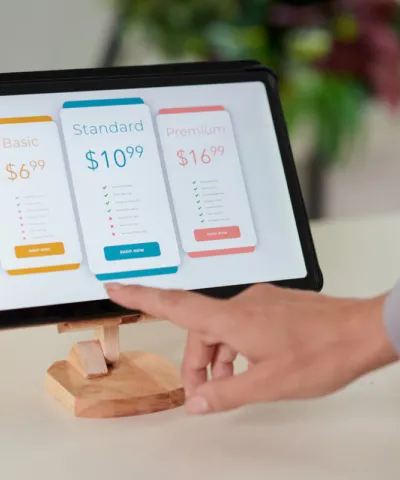“The single most important decision in evaluating a business is pricing power.” This is the insight of investment guru Warren Buffett. Unfortunately, companies rarely incorporate this principle into their day-to-day business.
Not adopting innovative pricing strategies can have a significant financial impact on your business success. Traditional models like cost-plus pricing and competition-based pricing don’t capture how much customers are really willing to pay for your product or service.
What is the price-quality relationship?
The price-quality relationship refers to the correlation between the price of a product and its perceived quality by customers. In general, customers often associate higher price points with higher quality, assuming that a more expensive product is of better quality than a cheaper one. This relationship can influence customers' purchasing decisions and their perception of the value they receive from a product.
What can companies do to improve their pricing?
The answer is to follow a value-based pricing approach. Unlike other price-setting approaches, production costs and competitors’ prices aren’t the sole factors used to calculate price.
Instead, customers pay for the value their new product offers them. To achieve this, companies need to assign a price to every product feature or characteristic. The more valuable features a product has, the higher its price needs to be.
Not only does a value-based pricing model fully tap customers' willingness to pay. It also improves the seller's reputation and its trustworthiness in the eyes of its customers. Customers usually perceive prices set using this method to be logical and transparent.
Three types of valuable product features
Identifying and measuring your value-enhancing attributes is the most significant hurdle in value-based pricing. However, we have identified three types of features that determine the value of a product:
- Hygiene factors, which must be present for customers to even consider buying the product
- Preference drivers, which determine whether a customer will buy a particular product over another
- Value drivers, which compel customers to pay a higher price for a product
Example: The value attributes of footwear
How does this apply in a practical scenario? Consider, for example, a consumer intending to purchase footwear.
The assortment of shoe sizes offered is a hygiene factor. The shoe must be available in the appropriate size with a particular feature for the customer to even contemplate purchasing it. If a product doesn't have this hygiene factor, the consumer dismisses it. So, if the shoe doesn't come in the correct size, the consumer won't purchase it, regardless of the cost.
Preference drivers dictate the product each consumer will select, influenced by their personal preferences. This could be, for example, the shoe's style or color.
The third category of features, value drivers, is where companies should pay particular attention. In the context of the shoe example, a value driver could be a material that the customer views as superior quality. So, it's something that customers are prepared to spend extra on.
Identify value drivers using market research
How can companies determine which of their products’ features are value drivers? A number of market research methods are available. These include the trade-off and MaxDiff methods, which enable companies to differentiate value drivers from hygiene factors and preference drivers.
In the trade-off method, potential customers are shown two products that differ in only one feature. Then they have to indicate whether there is a price difference between the two variants and which one they think is more expensive. The product feature that the majority of participants consider expensive is a value driver. If opinions vary too much, the feature is a preference driver.
The MaxDiff method provides even more insight. Market research participants receive lists of product features that they must evaluate according to the relevance for their purchase decision.
How to quantify willingness to pay
Once you have identified your products’ value drivers, you need to determine your customers’ willingness to pay. There are numerous explicit and implicit methods of questioning that you can employ.
You can ask indirect questions using a conjoint analysis. Here you ask test customers to rate products that differ in price as well as in their individual features. You then ask the customers to indicate which ones they would buy. You can then perform a statistical analysis to calculate the benefit of every product feature individually as well as the markup or discount you need to apply to each one.
You can use the Van Westendorp or Gabor-Granger methods to carry out direct price inquiries. The Van Westendorp technique involves customers rating the prices they consider too expensive, expensive, inexpensive, or too inexpensive for a specific product.
For the Gabor-Granger method, you randomly assign study participants product-price combinations. You then ask them to indicate how likely they are to buy each combination. However, you should be aware that these types of direct surveys often underestimate customers’ willingness to pay. It's important to also take the competitive situation into account.
That's why we recommend utilizing direct questioning methods merely as an addition to indirect strategies.
How to set your value-based prices
Once you have identified your products’ value drivers and their monetary value, you must translate these findings into specific prices. To do so, you need to apply the markups or discounts that you determined using the conjoint analysis to a base price.
This reference price applies to an entire product category and should be in the low or medium price segment of the market.
Conclusion: The benefits of value pricing
Setting prices based on manufacturing costs or competitors’ offers isn’t effective. You have much better chances of tapping into your profit potential with value-based pricing than cost-based pricing.
By embracing value-based pricing, you can unlock your profit potential and enhance your competitiveness in the market. It allows you to align your pricing with the perceived value by customers, leading to increased customer satisfaction, improved brand loyalty, and ultimately higher profit margins.
By identifying and leveraging value drivers, you can set prices that accurately reflect the quality of your products, leading to long-term success and sustainable growth in the market.
And value-based pricing not only helps you optimize the prices of your existing products. Understanding the characteristics that add value to a product can also assist you in creating new products. Moreover, if you are a company in the B2B sector, you can use added value to justify higher prices when selling to companies further down the supply chain.




